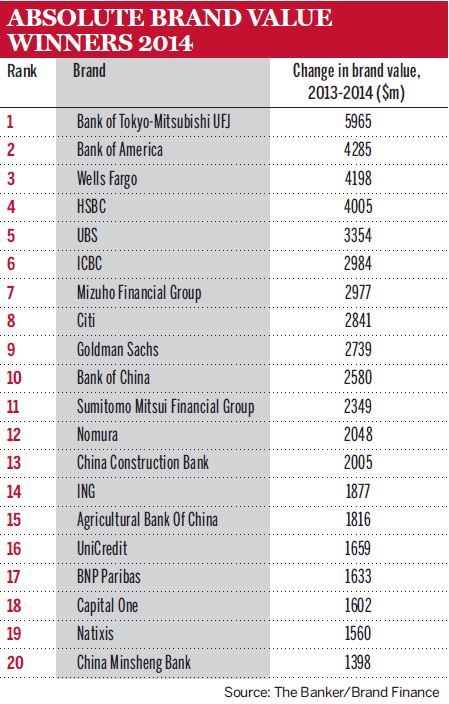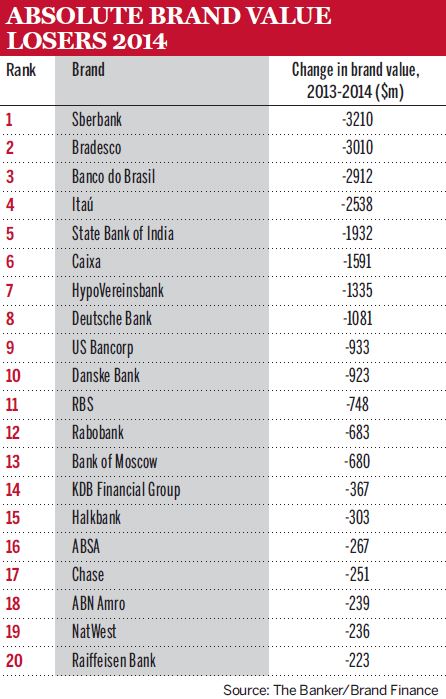
This month’s Banker magazine has its star feature focused upon the best banking brands in the world http://www.thebanker.com/Banker-Data/Banker-Rankings/The-Top-500-Banking-Brands-2014 . This is an annual report produced by The Banker with Brand Finance,
At the end of this blog entry, you will find The Banker’s analysis of the results this year, but here’s my brief view first.
The top 10 bank brands show an even spread across Europe (3 of the top 10 banks), America (4) and Asia (3).
The brand value list pretty much is the same as The Banker’s assessment of bank strength overall, as shown by the fact that the top 10 banks by brand value are pretty much the same names as those on The Banker’s list of top banks of the world published in July 2013 http://thefinanser.co.uk/fsclub/2013/07/the-worlds-top-20-banks-2013-.
(their position on the overall bank list from last year is in brackets)
1 Wells Fargo (US) (8)
2 HSBC (UK) (4)
3 Bank of America (US) (3)
4 Citi (US) (6)
5 JP Morgan Chase (US) (2)
6 ICBC (China) (1)
7 BNP Paribas (France) (11)
8 Santander (Spain) (14)
9 China Construction Bank (China) (5)
10 Agricultural Bank of China (China) (10)
JP Morgan slides thanks to the London Whale, whilst HSBC has shown a brand recovery after their disastrous year before with money laundering fines.
Intriguingly the biggest brand winners include some names you might not expect, with the Bank of Tokyo-Mitsubishi coming out on top. This is attributed to the bounce back of Japanese banks following recovery after the Fukushima nuclear outage.

Meanwhile, the biggest brand losers are coming from the BRI-C economies. By that, I mean Brazil, Russia and India but not China. The reason for these banks sliding in value is due to the uncertainty about the BRI-C economies maintaining their pace.

Anyways, here’s the full analysis from the Banker:
Brand valuations for US and European banks once again rose sharply. For emerging market lenders, the ranking looks less encouraging.
Brand values in this year’s Top 500 Banking Brands ranking have increased 14% from 2013, reflecting the continuing recovery of global banks from the financial crisis. Among the top 10 banks, eight saw their brand values rise by 9% or more.
Wells Fargo had another strong showing, topping the ranking for the second year in succession. Its brand value went from $26bn in 2013 to $30bn in 2014. HSBC moved up from third to second. Bank of America and Citi also jumped one place from last year to third and fourth, respectively. The bank brand to lose out to HSBC, Bank of America and Citi was Chase, which slipped from second to fifth spot, a result of its brand value declining 1% to $23.2bn.
Overall, developed world lenders had a good year. European institutions fared particularly well, reflecting the fact that their earnings projections and the perception of their riskiness – both important elements of their brand valuation – have improved as the eurozone crisis has abated and with many of them having increased their capital levels and cleansed their balance sheets of bad assets. “The brand values very much mirror banks’ share prices and market capitalisations,” says Bryn Anderson, chief operating officer of Brand Finance, the consultancy that did the research for the ranking.
Peripheral eurozone countries such as Ireland, Portugal and Greece stood out for positive reasons. The aggregate brand valuation of Greek banks rose a huge 101% between 2013 and 2014 to $2.1bn. Those of Irish and Portuguese lenders increased by 68% and 42%, respectively. Cyprus, however, is yet to put its financial problems behind it. Its banks saw their collective valuation fall 3% to $231m.
US banks managed to increase their valuations from $174bn to $194bn, ensuring that once again the country remained way ahead of any other in the ranking (China, in second place, has a total brand value of $113bn). UK banks saw their valuations increase 18% to $76bn, while German lenders enjoyed a 14% rise to $32bn.
Emerging market woes
Emerging markets suffered badly in this year’s ranking, underscoring the deepening concerns about the outlook for their economies. Russia’s Sberbank, which has the highest brand valuation of any non-Chinese emerging market lender, saw its valuation fall 23% to $11bn. Brazil’s Bradesco and Itaú saw their valuations decline by 22% and 20%, respectively.
Indian firms also had a glum year. The valuation of State Bank of India, the country’s biggest lender by assets and Tier 1 capital, slumped 32% from $6bn to $4bn.
One developing country that bucked the worsening trend was China. Of the BRICS – Brazil, Russia, India, China and South Africa – it was the only one to see the brand value of its banks climb. Moreover, the aggregate value of its lenders went up by a substantial amount, from $94bn to $113bn, an increase of 20%. This is likely a result of China’s economy still growing rapidly. “China seems to go from strength to strength,” says Mr Anderson.
China did not outpace every other country. One that performed even more strongly was Japan, which saw its banks’ valuation rise 60% to $59bn. This was in part due to the fact that their valuations went down heavily in the 2013 ranking amid the economic problems caused by the Fukushima nuclear accident. Bank of Tokyo-Mitsubishi UFJ’s valuation increased 51% to $17.6bn this year, while Sumitomo Mitsui Financial Group’s rose 43% to $7.8bn.
African banks made little headway. South Africa’s saw their total brand valuation dip by 4% to $5.7bn, while Nigeria’s, despite experiencing a big rise in profits and assets in the past few years, only managed to increase their brand values by 3% to $593m, suggesting they still have a long way to go in terms of building their brands.
Competition heats up
The figures from the ranking show that smaller banks are making faster progress than their larger counterparts. In 2014, the top 100 banks accounted for 78% of the brand valuation of the top 500. That figure fell from 81% last year. Similarly, the top 50 banks make up 63% of this year’s top 500 valuation, down from 65% in 2013.
What can be expected to happen over the next year? Mr Anderson believes that banks increasingly recognise the need to enhance the value of their brands. “Over the past year, banks have really been focusing on the customer,” he says. “They are beginning to understand that their brand is a valuable asset that needs to be managed. With the focus on customer satisfaction and competitiveness of the products they are offering, I think we will see brand strengths grow.”
For some markets, the need for banks to reinforce their brands is particularly pressing. The UK retail market, for one, is becoming more competitive as smaller businesses such as new challenger Metro Bank try to win more market share.
Overall, much will depend on economic conditions and how those affect banks’ businesses. The outlook for emerging market lenders in 2014 seems less sanguine than that for US and European ones, which are benefitting from their economies finally beginning to recover from the 2009 global crisis.
If those recoveries prove lasting, banks’ brand valuations will benefit. But the ones that boost their valuations the most will be those that do not just rely on improving economic conditions, but which actively seek to develop their brands through innovative means that make them stand out from their rivals.

METHODOLOGY
Brand Finance employs a discounted cash flow technique to discount estimated future royalties at an appropriate rate to arrive at a net present value of a bank’s trademark and associated intellectual property – its brand value.
The steps in this process are to:
1 - Obtain brand-specific financial and revenue data. The revenue was then segmented into the following revenue streams: retail banking, commercial banking, wholesale/investment banking, insurance, asset management and credit cards.
2 - Model the market to identify market demand and the position of individual banks in the context of all other market competitors.
Three forecast periods were used:
- Estimated financial results for 2012 using Institutional Brokers Estimate System (IBES) consensus forecast.
- A five-year forecast period (2013 to 2017) based on three sources: IBES, historic growth and gross domestic product (GDP) growth.
- Perpetuity growth based on a combination of growth expectations (GDP and IBES).
3 - Establish the royalty rate for each bank by:
- Calculating brand strength on a scale of zero to 100 according to a number of attributes, including asset strength, emotional connection, market share and profitability.
- Determining the royalty rate for each revenue stream mentioned in step one.
- Calculating the future royalty income stream.
4 - Calculate the discount rate specific to each bank, taking account of its size, geographical presence, reputation, gearing and brand rating (see below).
5 - Discount future royalty stream (explicit forecast and perpetuity periods) to a net present value – the brand value.
Royalty relief approach
Brand Finance uses a ‘relief from royalty’ methodology that determines the value of the brand in relation to the royalty rate that would be payable for its use, were it owned by a third party. The royalty rate is applied to future revenue to determine an earnings stream that is attributable to the brand. The brand earnings stream is then discounted back to a net present value. This approach is used for two reasons: it is favoured by tax authorities and the courts because it calculates brand values by reference to documented third-party transactions and it can be done based on publicly available financial information.
Brand ratings
These are calculated using Brand Finance’s ßrandßeta analysis, which benchmarks the strength, risk and potential of a brand relative to its competitors, on a scale from AAA to D. Conceptually, it is similar to a credit rating. The data used to calculate the ratings comes from various sources including Bloomberg annual reports and Brand Finance research.
Brand ratings definitions:
AAA Extremely strong
AA Very strong
A Strong
BBB-B Average
CCC-C Weak
DDD-D Failing
Valuation date: All brand values in the report are for the year ending December 31, 2012
For full results, download the PDF:
Top 500 Banking Brands, 2014.pdf 251.90 kB
Previous rankings
Chris M Skinner
Chris Skinner is best known as an independent commentator on the financial markets through his blog, TheFinanser.com, as author of the bestselling book Digital Bank, and Chair of the European networking forum the Financial Services Club. He has been voted one of the most influential people in banking by The Financial Brand (as well as one of the best blogs), a FinTech Titan (Next Bank), one of the Fintech Leaders you need to follow (City AM, Deluxe and Jax Finance), as well as one of the Top 40 most influential people in financial technology by the Wall Street Journal's Financial News. To learn more click here...

